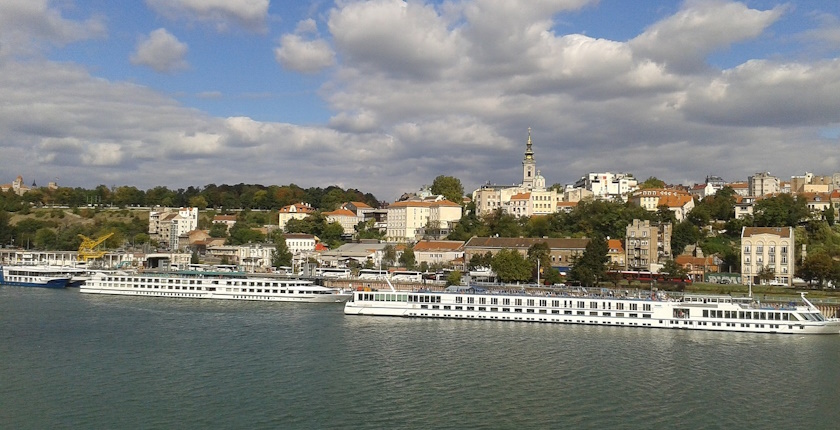
Photo: oto: Aleksandar Ciric from Pixabay
The central urban part of Belgrade has only 2.83% of green areas, compered to barely over 12% in its entire territory with suburban greenery and forests. The lack of greenery combined with high building density and materials such as concrete, asphalt, metal, and glass, which absorb a large amount of heat, contribute to the creation of heat islands. Data from a new scientific study has shown that in the central part of Serbia’s capital, temperatures in areas with the least greenery are on average seven degrees Celsius above the lowest measured level.
The impact of climate change is becoming more drastic. Last year was the warmest on record, and scientists expect 2024 to be even warmer. Urbanization directly affects temperature, air humidity, wind speed, solar radiation, and other meteorological parameters, creating a climate specific to cities.
There is only 12% of green spaces across the entire territory of Belgrade while in its central part their share is only 2.83%. It leads to the retention of more heat and the creation of so-called urban heat islands.
The significance of green spaces is highlighted in a research paper conducted by teams from the Faculty of Sciences in Novi Sad, Faculty of Geography and Geographic Institute in Belgrade, all in Serbia, and the Faculty of Philosophy in Istočno Sarajevo in Bosnia and Herzegovina.
Residential and commercial complexes are built at the expense of green spaces
“As a resident of Belgrade, I now notice that the concreting of Belgrade is intensive and that it is trees and green areas that most oftenly pay the high price. There are less and less of them. We increasingly see groups of citizens rising to defend small parks threatened by the construction of new residential-commercial zones,” said Milica Lukić, one of the researchers from the Faculty of Geography in Belgrade and a member of the WISE Serbia network of women.
Scientists analyzed microclimatic conditions in different urban environments to raise awareness of temperature conditions in the city and contribute to creating urban planning and design strategies that take climate issues into account.
Measurements included air temperature and thermal stress, which is the heat load on organisms and structures.
“We used a special measurement device that very reliably records parameters necessary for urban microclimatic research – KESTREL,” Lukić explained.

Temperature was measured in June and August 2021 at five locations: Obilićev venac, Đure Jakšića Street, Košutnjak, Studentski park, and next to the Institute for Biological Research Siniša Stanković. The widest temperature differences between densely built and green areas were recorded in the hottest part of the day, between 2:00 pm and 3:30 pm. At some locations, they exceeded seven degrees Celsius.
For example, on August 23, the maximum air temperature was 40.6 degrees in Đure Jakšića Street, while in Studentski park it was only 33.4 degrees Celsius.
“What is alarming is that, in this case, we are talking about a distance of just a few hundred meters, but the microclimatic and bioclimatic conditions are completely different,” Lukić stressed.
The results were presented in the scientific paper ‘Thermal assessments at local and micro scales during hot summer days: a case study of Belgrade (Serbia).’ It was published in the journal Időjárás of the Hungarian Meteorological Service.
Green spaces are necessary for Belgrade to adapt to changing climate conditions
In summer months, high temperatures can cause a high degree of thermal discomfort, which mostly affects children, pregnant women, the elderly, and chronic patients. It shows how important urban greenery is for urban microclimate and how much it can positively affect the general wellbeing of citizens.

Lukić pointed out it is particularly worrying that the climate is changing much faster than we can imagine. March was the warmest in recorded history, and Belgrade had the highest average March temperature in the last 136 years, since meteorological measurements began. It was 12.1 degrees Celsius.
Lukić: Intense heatwaves are yet to come
“In such altered climate conditions, where we already feel the consequences of climate change on our skin, temperature records are being broken from month to month, and climate projections show it will continue and that we are yet to experience intense heatwaves, we must seriously reconsider the urban development policy of cities in Serbia,” said Lukić.
The data from the research has shown that green spaces in central urban areas are necessary for a city to adapt to changing climate conditions because they can lower air temperature by up to seven degrees Celsius in the hottest parts of the day, when thermal discomfort outdoors is the most pronounced.
Implementation of strategic documents as a solution
In 2019, the Assembly of the City of Belgrade adopted the General Regulation Plan for Green Areas System, which contains all recommendations and guidelines on how to plan the development of green spaces in Belgrade. “However, after five years, little has been materialized. Unfortunately, this very important document, which can greatly help in combating the consequences of climate change, remains for now a dead letter on paper,” said Lukić.
In 2021, the Assembly of the City of Belgrade adopted two important documents: the Green City Action Plan and the Sustainable Energy and Climate Action Plan. The latter addresses the issue of green infrastructure and urban planning.
However, despite good recommendations and guidelines, the implementation has not progressed far.
“My personal appeal to the authorities, namely first and foremost to the Belgrade City Administration and the City Assembly, is to start implementing these strategically very important planning documents as soon as possible, as their implementation would greatly help Belgrade to adapt to changing climate conditions,” Lukić concluded.


















Unfortunately it seams that there is no forward thinking or taking big picture in consideration not only in Serbia but almost everywhere when comes to urban planing.
We have used and abused mother earth and everything on her so no wonder things are turning as they are.